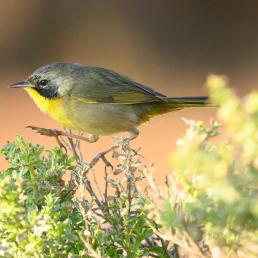

Join BirdNote tomorrow, November 30th!
Illustrator David Sibley and actor H. Jon Benjamin will face off in the bird illustration battle of the century during BirdNote's Year-end Celebration and Auction!
Have you ever seen a bird foraging in the rain and wondered why it isn't soaked to the bone? While every bird wears one feather coat, different kinds of feathers – and even different parts of the same feather – can perform various functions. The outermost tips of the main body feathers, called the contour feathers, are built so that the feather surface forms a fine, breathable but water-resistant mesh. This water-repellent property allows the downy bases of the same contour feathers, and other completely downy feathers, to stay dry underneath, allowing them to trap warm air. Don't you wish we had such warm, dry, light, great-looking coats?
BirdNote®
When Birds Get Wet
Written by Bob Sundstrom
This is BirdNote.
[Rainfall]
For birds, rain is a fact of life. [Black-capped Chickadee call]
They might take cover during a drenching downpour, but when it showers all day, they still have to brave it and find food. [Black-capped Chickadee call]
Chickadees still fly to feeders for sunflower seeds, right through a cold winter rain. Fortunately, a bird’s outer layers of body feathers, known as contour feathers, prevent rain from penetrating toward its core. The fine structure of contour feathers interlocks each feather with the next, creating a barrier to water, and keeping it from reaching the down feathers where birds trap air for warming insulation. [Black-capped Chickadee call, http://macaulaylibrary.org/audio/98802, 0.08-.12]
Many birds also apply an oil to their feathers while preening, using their bills to spread oil from a gland at the base of the tail. The oil isn’t so much a waterproofing substance as a conditioning lubricant that keeps feathers supple, allowing their fine structure to mesh and repel water. Birds that don't have an oil gland, like some parrots*, grow special down feathers that disintegrate into a very fine, waxy substance called powder down. When preened onto the contour feathers, powder down also helps repel water.
So bring on the rain! It’s warm and dry under those feathers. [Black-capped Chickadee song: http://macaulaylibrary.org/audio/191262, 0.10-.15]
###
Bird sounds provided by The Macaulay Library of Natural Sounds at the Cornell Lab of Ornithology, Ithaca, New York. Call of the Black-capped Chickadee [191262] recorded by R S Little; song of the Black-capped Chickadee [98802] recorded by G A Keller.
BirdNote's theme music was composed and played by Nancy Rumbel and John Kessler.
Producer: John Kessler
Executive Producer: Dominic Black
© 2015 Tune In to Nature.org January 2018/2019/2021 Narrator: Mary McCann
ID# feather-03-2015-01-26feather-03
* Editor's note: Only SOME parrots produce "powder down" -- cockatoos, cockatiels, and a few other species, like grey parrots. Most other parrots, such as the lories, macaws, and Amazons, have a preen gland that produces oil.





